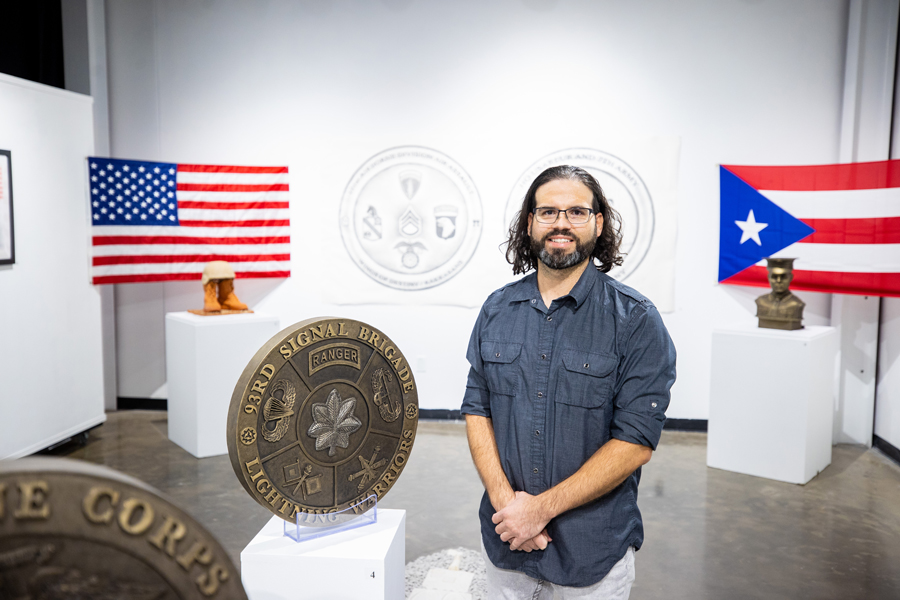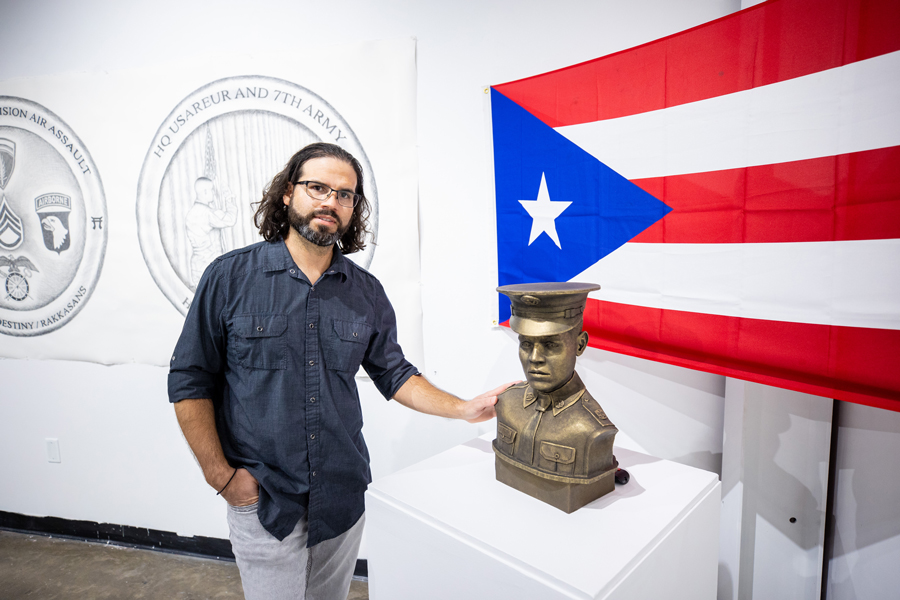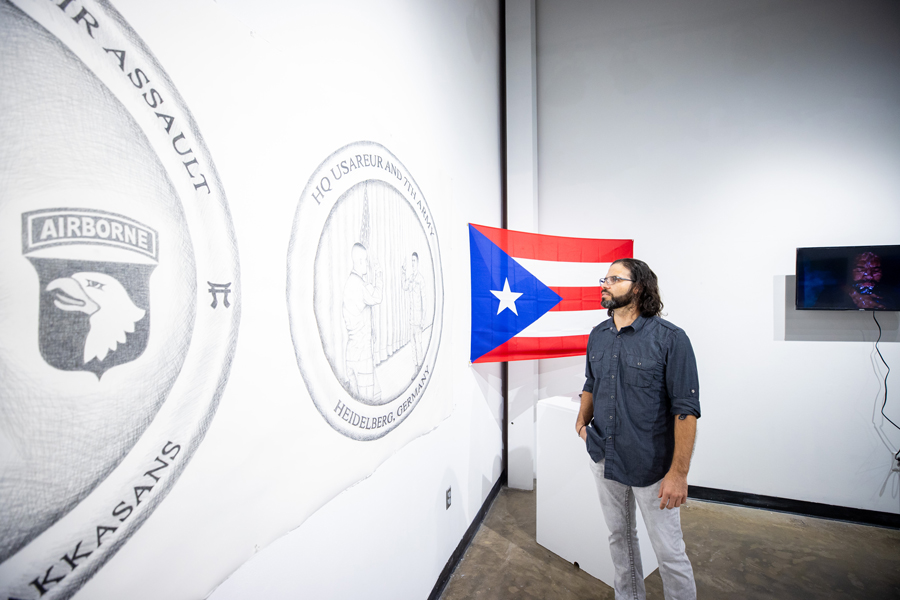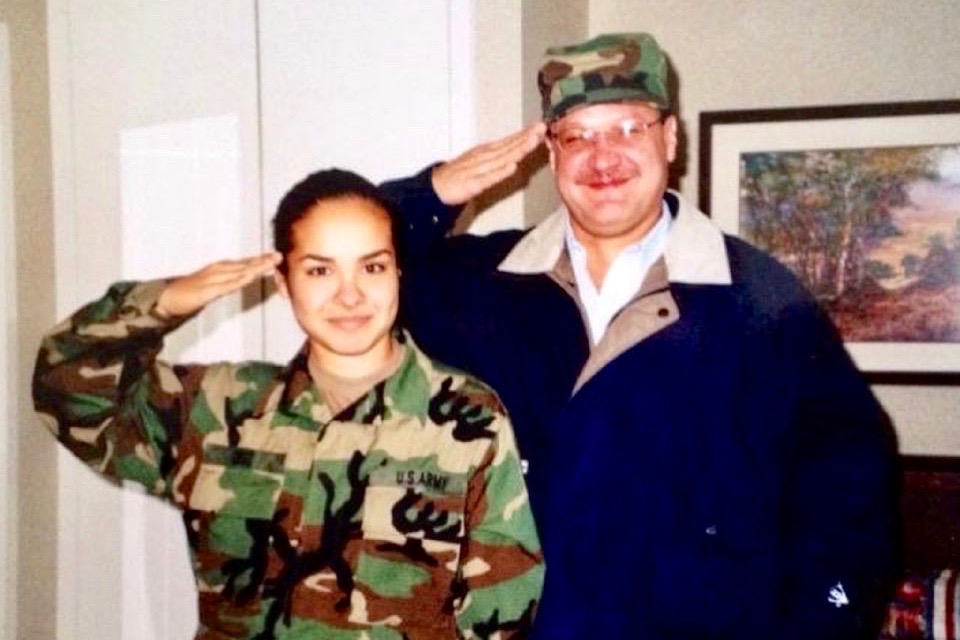
Carlos Carpena
“To me, Austin Peay’s Center of Excellence for the Creative Arts (CECA) is like a portal of endless possibilities for students, where you can take the most relevant information from diverse sources to use it for your benefit. You can take drawing, painting, anything you like, and use it to your benefit. You choose what you want to do, and CECA provides that to you, helps you do that.”
Major: Art + Design
Graduation Year: December 2021
Campus Involvement: CECA Scholarship Recipient
Hometown: Clarksville, Tennessee
As a boy growing up in Puerto Rico, Carlos R. Carpena often heard stories about his grandfather and the “Borinqueneers.” In the late summer of 1950, those young men – members of the island’s 65th Infantry Regiment – headed east to reinforce their fellow U.S. soldiers during the opening months of the Korean War.
According to the National Guard’s official website, “Sent into action immediately, the Puerto Ricans took part in the United States breakout and drive to the north. Following the brilliantly planned and executed surprise landings at Inchon, (the) United States and other United Nations forces drove deep into the mountains of North Korea.”
The fighting continued for years, with the “Borinqueneers” – named for Puerto Rico’s original name, Borinquen – earning the motto, “Honor and Fidelity.” But during one bloody battle, Carpena’s grandfather disappeared. No one ever saw him again.
“Unfortunately, they never recovered his body,” Carpena said. “I believe he is considered, ‘Missing in Action.’”
Carpena never met this grandfather, but that brave man’s noble service influenced the family for generations, with his Puerto Rican descendants serving in the military, from the Vietnam War up to the 21st century’s Global War on Terrorism. When Carpena retired from the U.S. Army in 2014, he thought about exploring this legacy while studying art at Austin Peay State University.
In late November 2021, his emotional journey finally came to a healing end when, thanks to an APSU Center of Excellence for the Creative Arts Scholarship, he presented a powerful exhibition detailing the military’s influence on Puerto Rican culture and his family.
“My grandfather’s military service inspires this project,” Carpena wrote in an artist statement for the project. “Once before, I was motivated by him when I enlisted in the U.S. Army. Now, I’m proud to do this work to honor the legacy he passed down to my family.”
Challenge Coins
On a cold, rainy morning in November, Carpena stood quietly amid his work – sculptures, charcoal drawings, video productions and other pieces – inside the APSU Art + Design Building’s Barbara Beach Gallery. His dark hair, once clipped tight in a military crew cut, now reached to his shoulders, and a little gray softened his dark beard.
In 2000, at the age of 22, Carpena earned his associate degree in drafting from Huertas Junior College, and following a short career as a drafting teacher, he enrolled in the U.S. Army. But to understand his military career, one needs to look closer at his family legacy.
To do that, Carpena sculpted a series of large challenge coins depicting his family’s service. The pieces were made using EVA foam and acrylic paint to give them a bronze color.
“One of the military traditions is the use of the challenge coins,” he wrote in a description of the exhibit. “They are usually given as an award for an honorable act, or a job well done to display the achievements, gratitude and appreciation the command group has toward their members.”
The first coin in the series features Carpena’s grandfather on the front and the words “Honor Et Fidelitas” on the back.
“To talk about my career, I have to talk about everybody who served before me,” he said. “That’s the way to understand my own career.”
The coins that followed depicted helicopters hovering over a jungle and women in the U.S. Marine Corps – tributes to his late Vietnam veteran uncle and his “leatherneck” sister.
Carpena also made a coin highlighting his older brother’s career, but this sibling – a recently retired lieutenant colonel – is also featured prominently in a large charcoal sketch Carpena made of his own military service.
“This shows a special moment in my career,” he said. “It shows my brother doing the re-enlistment ceremony for me. He was a company commander in Korea when I was in Germany, and he flew up to do the ceremony. That was a turning point for me – to stay in the Army or get out – and after I decided to stay, he did the honor of my re-enlistment. If I was going to make a coin, I would put that moment that changed my career.”

Borniqueneer
Carpena moved slowly past the coins and then paused at a white pedestal holding the bust of a soldier. The clay sculpture, painted bronze, showed a handsome young soldier wearing a U.S. Army hat. The face, molded into a realistic, three-dimensional form, depicted someone Carpena only knew from stories and two-dimensional photographs. It was his grandfather.
“Everything here is personal and emotional to me.” He blinked hard. “While I was doing this and the research, it took a big toll on me. It was hard. I wanted to celebrate his service because my mom, she hasn’t, how should I say, she’s still hurt because she never met him. Everything she knows is from old stories of family members. It’s been hard for her to talk about this moment.
“When I was doing this I was kind of scared to tell her what I was doing. After she was surprised, but at the same time, she doesn’t have any closure to it. It was hard for her to see this piece. Then she accepted it and was fine with it. But until they find his body or remains, she won’t have any closure.”
CECA
The other pieces in the exhibit, from a video interpretation of PTSD to a painting of baseball legend and soldier Roberto Clemente, demonstrate that Carpena’s story isn’t unique. Most Puerto Ricans, he said, have a military legacy in their family.
“Puerto Rico is 100 miles by 35 miles, and in that small island, we have 58 army posts,” he said. “In the 1940s and 1950s, you were either a farmer or a soldier. That’s what most people did to take care of their family, and then later people wanted to join the army to do the same thing as their grandfather or their brother or their sister.”
Carpena wanted to highlight this aspect of his island’s history, and after earning a bachelor’s degree at Austin Peay in engineering technology, he decided to return for a second degree.
“While I was getting that degree at Fort Campbell, when I was about to graduate, I found out they had an art major,” he said. “I decided to continue, and I realized this was my passion, this is what I love to do. I like engineering, but this is my passion.”
But while he was pursuing his passion, he found himself – thanks to the APSU Department of Art + Design and CECA – letting go of hurtful feelings.
“This has helped me talk about my own career, accept it, realize what I’ve been going through and be grateful I’m still here,” he said.
He looked back on his exhibit, which closed that day.
“To me, CECA is like a portal of endless possibilities for students, where you can take the most relevant information from diverse sources to use it for your benefit,” he said, quoting his CECA scholarship application. “You can take drawing, painting, anything you like, and use it to your benefit. You choose what you want to do, and CECA provides that to you, helps you do that.”
Carpena graduated from Austin Peay in December 2021 with his Bachelor of Fine Arts degree.
Related:
- Graduate student Austin Derden uses his degree and experience to help others at APSU's Newton Military Family Resource Center.
- Recent graduate Christaine Patton shows her daughter that anything can be accomplished.
- Daniel Cole used his time here at APSU to learn the skills and leadership needed to better serve his country.

